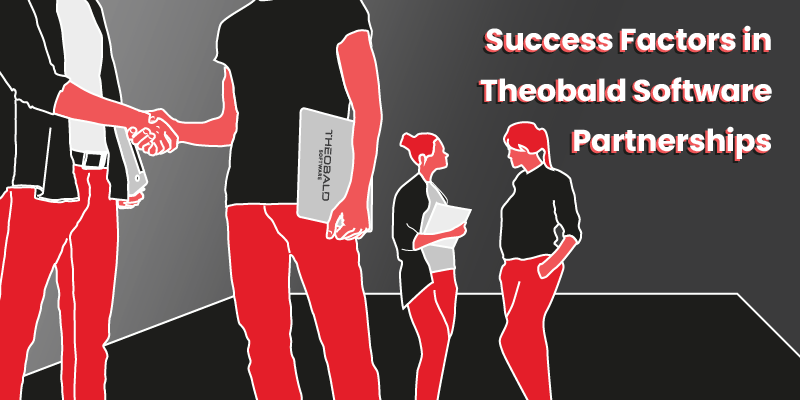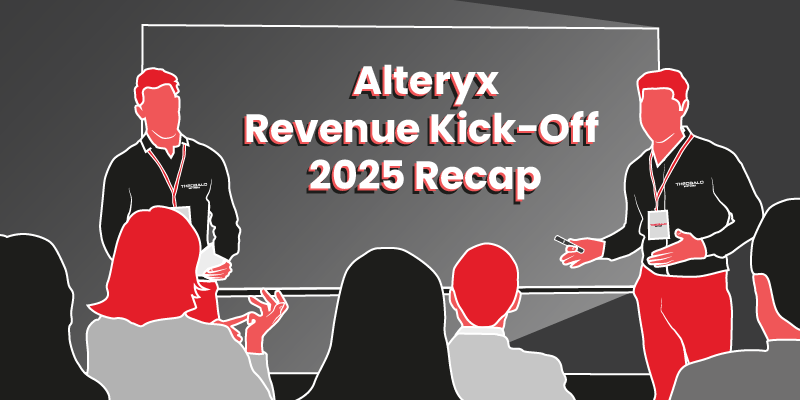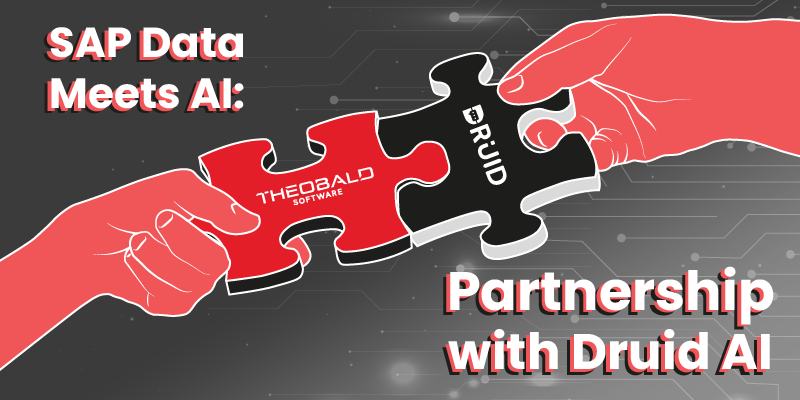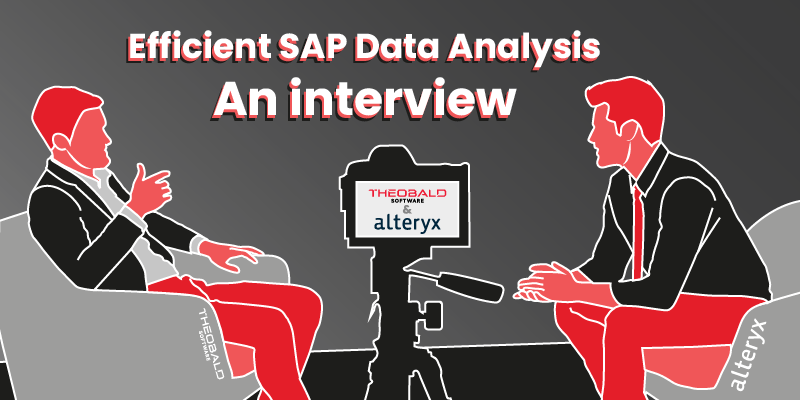
Theobald Software Partner Ecosystem – Keys to a successful partnership
As I sit at my desk reflecting on a long and productive week at the 2024 Alteryx Inspire conference, I am struck again by the promise and potential of thoughtful and well executed technology partnerships. After spending many hours engaging in numerous conversations at Alteryx Inspire 2024 with our joint customers, it was very clear that the benefits of integrating Theobald Software SAP Extract capabilities into the Alteryx Designer toolset was very obvious to our thousands of existing and potential new customers.
So, how did Alteryx and Theobald Software reach our current technology partnership, and how did this partnership produce a joint solution that provides such significant benefit? And I also look into the questions: Why do we work with partners, and what considerations are important in a successful partnership?
Key Considerations Before Partnering
There is a myriad of paths you can follow to get to a successful technology partnership, but there is no guarantee that what works for one partner(s) works for your own situation or can be applied successfully to another partner. Well before a technology partnership provides significant benefit and pays dividends for both customers and partners, there are some important factors that must be considered – well before any benefits are seen. Before I expand on the successful partnership between Theobald Software and Alteryx, I thought it would be useful to answer a key question: Why (or why not!) a partnership should be considered, and what are some key factors to evaluate when entering and building partnerships?
Many common and well-known technology partnerships provide simple, obvious benefits. Anyone ever used Uber? Uber ride sharing software and Google Maps geolocation capability are powerful examples of complementary technologies that provide obvious value and benefit to customers and partners alike. In hindsight this technology partnership seems obvious – but early on this is very often not the case.
Potential Benefits and Efficiency Gains
First – the question of Why? In my experience the fundamental question to be answered is quite simple: Does the combination of Partner A and Partner B technologies and/or capabilities provide customer benefit that otherwise would not exist with each partner by itself? Note that answering this question from the perspective of the intended customers is important. If both partners benefit, but customer value is non-existent and difficult to explain or grasp quickly, any potential partnership will struggle to grow and succeed over the long term. Do not forget the customer!
Once a clear customer benefit or value is established, both prospective partners need to consider some key questions before moving forward. A key point is the need to consider these questions from different business perspectives. A Product Manager prioritizes and values a potential partnership differently than does a Sales Director, and in turn a Marketing lead looks for specific areas of value that is different again. All perspectives are important, but depending on the partnership’s goals, one may be more important than the others. As an example, if the goal of the partnership is to address a specific feature gap or key capability that has been highlighted in customer feedback, the Product Manager evaluation and viewpoint is particularly important – Sales and Marketing may be well aligned, but if the feature gap is not addressed the customer will still be dissatisfied, no matter how effective the combined Marketing and Sales efforts are.
Business Objectives and Success Metrics
What follows is not an exhaustive list, but in my experience asking these questions assists in establishing a useful framework for evaluating prospective partnerships.
What are the key business objectives of the partnership? Some example questions:
- Will the partnership give me access to new industry verticals and/or new customers I cannot otherwise reach alone?
- Will the partnership increase existing customer retention (asked another way, will it lower customer churn?)
- Will the partnership increase brand awareness, increase NPS, increase customer satisfaction or ideally all the above?
- Will the partnership allow our organization to scale to levels that we cannot achieve on our own? A common objective in this regard is the desire to scale your Sales team coverage by leveraging the Partner Sales teams and aligning pricing and compensation incentives.
- How will I monetize this partnership and drive revenue growth?
- For the key business objectives identified for the partnership, how will I measure success against these objectives? It is important to consider both short- and long-term objectives – they may be the same but often they are markedly different. For example, a partner may be solely focused on gaining market share in the first 12-24 months of a partnership, but thereafter profitability is most important and market share is secondary.
What other potential benefits can I potentially realize in the partnership?
- Will the partnership reduce costs and produce increased efficiency gains for our own organization? For our partner? For customers?
- What specific business functions (Sales, Customer Success, Marketing etc.) will benefit from the partnerships, and how will we measure these benefits?
- Does the new partnership allow our organization or our customers to reduce risk? For example, will the proposed partnership reduce risk associated with single threaded vendor or technology supplier bottlenecks or capacity shortages?
What is the impact of the proposed partnership on our joint customers?
- From a purchase and implementation perspective, will the partnership increase friction, or will it streamline how a customer deals with each partner individually and collectively?
- Is the pricing and the product/service delivery to customers well understood by both partners, and do customers understand how to procure, implement, and onboard the solution quickly? How will prospective customers get up to speed and be productive efficiently?
- Are there potential complications that may arise from a product security, licensing, and enablement perspective that the partners can address pre-emptively so that customers are not forced to deal with each organization separately?
Does my own organization support the new potential partnership, and are they willing to invest in the partnership now and on an ongoing basis?
- Who are the key internal stakeholders required to engage in the partnership for success?
- What investment is required (Funding, Development or Engineering resources and capacity, Marketing campaigns etc.), and what is the approximate level of effort over time?
- If revenue allocation or sharing between the partners is part of the agreement, how will this be executed, recognized, and tracked in our internal systems?
To reiterate an important point, the questions presented above are not an exhaustive list, but will provide a useful starting point to objectively evaluate not only the need for a partnership in the first place, but also whether a proposed partnership will address key business objectives and whether your own organization is prepared to invest in and support a new technology partnership.
Customer Benefits of the Theobald Software x Alteryx Solution
Returning to my experience at the 2024 Alteryx Inspire conference and thinking about our partnership with the Alteryx team, it is obvious that some of these key questions were addressed and answered. The result is that both partners can meet key business objectives, and more importantly our customers easily see and understand the benefits that our integrated solution in the Alteryx Designer toolset provides:
- Effective Data Analytics solutions are focused on garnering insights and answers from numerous data sources, NOT on the data itself and how to extract, transform and cleanse that data. The Xtract for Alteryx (XfA) solution puts SAP data into the Alteryx data flow quickly and accurately, allowing users to focus on answers and insights quickly and efficiently.
- The incredibly significant presence of SAP ERP software broadly across every industry and business function places SAP as the critical data source for tens of thousands of organizations – private and public. Data analysis and analytics functions require this data for key business insights and decisions. The partnership between Theobald Software and Alteryx makes data extraction from SAP easy and the time to value for the joint solution very fast.
- The embedded solution in place – Theobald Software capabilities seamlessly integrated into the Alteryx Designer toolset – allows users to set up data extraction from SAP quickly and then easily combine with non-SAP data in a dataflow using the familiar, no-code drag and drop Alteryx interface.
- The integrated solution requires no new security or authorization changes – Xtract for Alteryx simply leverages the same secure SAP authorization framework that is already in place.
- The Customer Procurement process is enabled by a joint GTM, pricing and licensing agreement, which streamlines and simplifies the customer experience for purchase and onboarding. Time to value is fast and low friction.
Effective Technology Partnerships and Alliances provide customer benefit that is simple to understand and benefit from. There are many types of Technology partnerships (Reseller, SI/GSI, OEM, ISV, MSP etc.) that are formed, and these partnerships are often quite different in how they are structured and in the benefits they will provide.
In my next Technology Partner focused post, I will outline some of the most common Technology Partner types, and why you might consider engaging in one type vs. another.

Scott Pattinson
Scott is ISV/OEM Partner Manager at Theobald Software in the U.S.
One Comment
Leave A Comment Cancel reply
More relevant posts
Strengthening Partnerships: Our Takeaways from Alteryx RKO 2025
Energy. Anticipation. Excitement. As the welcome reception kicks off, the room quickly fills with lively conversations, even drowning out the live music (as expected in Austin!). Every year, Alteryx [...]
By Tyler Reynolds|Published On: February 10th, 2025|Categories: Event Highlights, Partner News & Updates|Maximizing SAP Potential with AI: Theobald Software Partners with DRUID AI
How can businesses make working with SAP systems more efficient and user-friendly? The answer lies in combining innovative AI technology with seamless integration. Together with our new partner, DRUID [...]
Efficient SAP Data Analysis for Informed Decision-Making
As the demand for processing and analyzing data continues to grow among many companies, so does the need for user-friendly self-service tools. Alteryx, a leading provider of data science [...]







This is a nice summary, not only of the specific advantages our partnership with Alteryx provides for both partner, but also of the benefits that our joint customers can derive from it. Helping customers to better monitor their SAP Migration or Modernization projects is only one of the many use cases we are helping with.